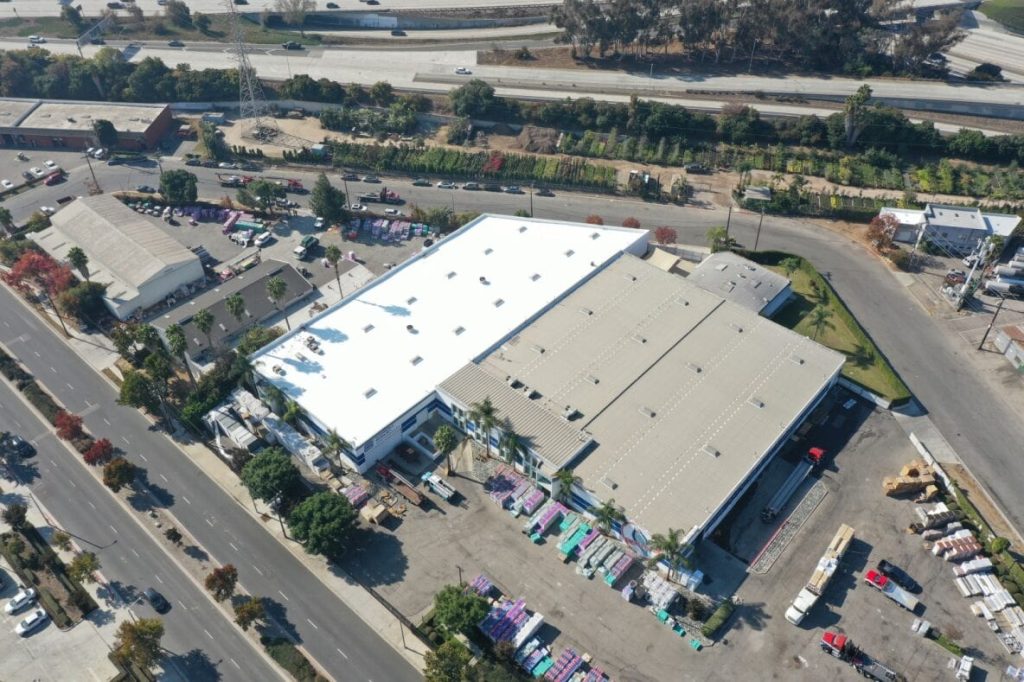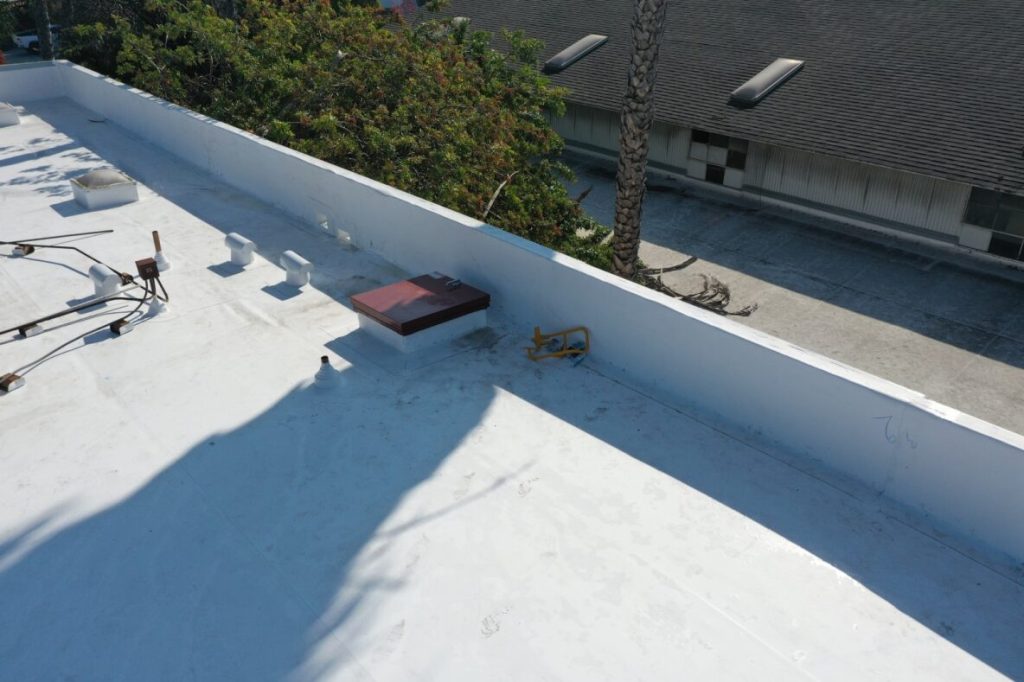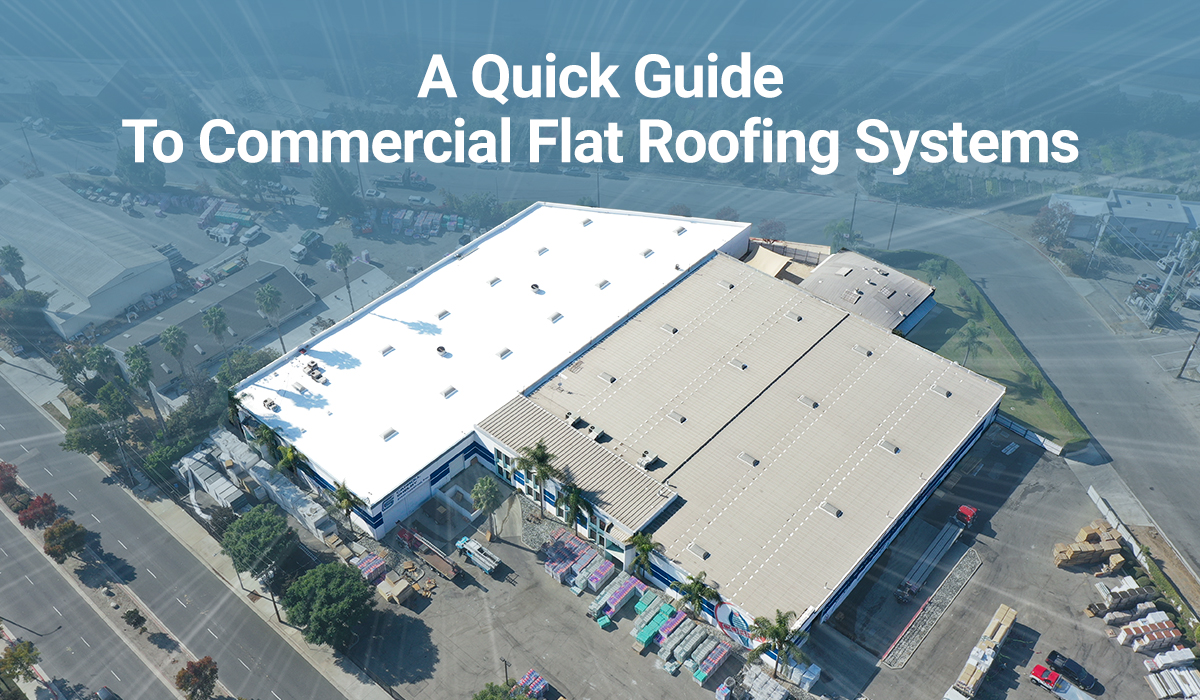Commercial flat roofing is one of the most practical and cost-effective solutions for business buildings. Whether you are constructing a new commercial property or replacing an existing roof, choosing the right commercial flat roofing system is critical for ensuring the longevity and efficiency of your building. In this guide, we will walk you through the different types of commercial flat roofs, their benefits, how to maintain them, and the installation process. By the end, you’ll have the knowledge needed to choose the best roofing system for your needs.

What is Commercial Flat Roofing?
Commercial flat roofing is a roofing system characterized by its nearly horizontal structure. Unlike traditional pitched roofs, flat roofs have only a slight slope, usually about 1/4 inch per foot. This design allows for efficient use of space and is particularly popular for commercial buildings like offices, warehouses, retail centers, and factories.
Flat roofs are often chosen for their practical advantages, such as providing usable space for HVAC units, solar panels, or even green roofs. Additionally, they are cost-effective to install and maintain, making them a top choice for many businesses.
Key Features of Commercial Flat Roofing:
- Low slope design: Typically a slope of 1/4 inch per foot, ensuring water drainage.
- Cost-effective installation: Flat roofs tend to require less material and labor than pitched roofs, making them a budget-friendly option.
- Energy efficiency: Some flat roofing materials, such as TPO or reflective coatings, help reduce cooling costs by reflecting UV rays.
- Extra usable space: Flat roofs can serve as additional spaces for equipment, storage, or even recreational areas.

Types of Commercial Flat Roofing Systems
When it comes to choosing the best commercial flat roofing system, businesses can select from several materials, each with unique features, benefits, and price points. Here are the most commonly used flat roofing options:
Built-Up Roofing (BUR)
Built-Up Roofing, or BUR, is a traditional flat roofing system made from multiple layers of bitumen (asphalt) combined with fabric reinforcement. These layers are sealed together using hot tar or asphalt, followed by a layer of gravel or reflective coatings to protect the surface.
Benefits of BUR:
- Longevity: BUR roofs are known for their long lifespan, often lasting 20 years or more with proper maintenance.
- Durability: This system offers excellent protection against water infiltration and harsh weather conditions.
- Low maintenance: Although the initial installation cost can be higher, the long-term maintenance needs are minimal.
- Fire Resistance: The asphalt layers provide fire-resistant properties.
Modified Bitumen Roofing
Modified Bitumen roofing is an evolution of the BUR system. It uses sheets of bitumen that are modified with polymers to increase flexibility and resilience. The sheets are either torch-applied (heated to adhere to the surface) or adhered using adhesives.
Benefits of Modified Bitumen:
- Flexibility: This roofing material is more flexible than BUR, making it ideal for areas with fluctuating temperatures.
- UV Resistance: Modified bitumen is highly resistant to UV radiation, preventing the roof from degrading over time.
- Ease of installation: Modified bitumen is often easier to install compared to BUR, and it can be installed in fewer layers.
- Cost-Effective: It provides excellent value by combining durability and affordability.
EPDM (Ethylene Propylene Diene Monomer) Roofing
EPDM is a single-ply synthetic rubber roofing membrane. It’s one of the most popular choices for commercial flat roofing due to its durability, cost-effectiveness, and ease of installation. EPDM roofing is also known for its long lifespan and resistance to UV rays, ozone, and extreme temperatures.
Benefits of EPDM Roofing:
- Long lifespan: EPDM roofs can last 30 years or more when properly maintained.
- Energy Efficiency: EPDM membranes can be white, helping to reflect heat and reduce cooling costs in commercial buildings.
- Easy to install: EPDM is relatively easy to install and can be applied quickly to reduce labor costs.
- Low maintenance: Once installed, EPDM roofs require minimal maintenance.
TPO (Thermoplastic Olefin) Roofing
TPO is a single-ply membrane made from a combination of rubber and plastic. It’s an increasingly popular option for commercial flat roofs because of its excellent energy efficiency and environmental benefits.
Benefits of TPO Roofing:
- Energy Efficiency: TPO reflects UV rays, reducing the building’s cooling needs and lowering energy costs.
- Durability: TPO is resistant to punctures, tears, and impacts, making it ideal for areas that experience high foot traffic.
- Easy Installation: TPO’s heat-welded seams provide superior water resistance and ease of installation.
- Eco-Friendly: TPO is often made from recyclable materials, making it a more sustainable roofing option.
Benefits of Commercial Flat Roofing Systems
Commercial flat roofing systems offer several advantages, which make them a go-to option for businesses. Here are some of the main benefits of flat roofs:
Durability and Longevity
The durability of commercial flat roofing systems is a major selling point. When properly installed and maintained, many flat roofing systems can last for 20-30 years or more. Materials like BUR and modified bitumen can last longer, making them a long-term investment for your commercial property.
Cost-Effectiveness
Flat roofs are often more affordable to install than sloped roofs. The materials used for flat roofs are less expensive, and the labor costs tend to be lower because the roof’s design is simpler. Additionally, flat roofs require fewer materials for construction, which can also contribute to reduced costs.
Energy Efficiency
Flat roofing systems like TPO and EPDM come with reflective coatings that help reduce the amount of heat absorbed by the building. This can significantly lower energy bills by reducing the need for air conditioning during hot months. Flat roofs are particularly beneficial in hot climates, where reflective materials can be a game-changer for energy savings.
Additional Usable Space
One of the most significant advantages of commercial flat roofs is the space they provide. This extra space can be utilized for various purposes, such as:
- Installing HVAC units to save space inside the building.
- Adding solar panels to reduce energy costs and increase sustainability.
- Creating green roofs for aesthetic purposes and to contribute to sustainability.
How to Maintain Your Commercial Flat Roof
To extend the lifespan of your commercial flat roof and ensure it performs at its best, regular maintenance is necessary. Below are some key maintenance practices to follow:
Regular Inspections
Regular roof inspections can identify potential problems before they become major issues. During an inspection, a professional roofing contractor will check for:
- Cracks or blisters in the roofing material.
- Damage to seams and edges.
- Ponding water that may be indicative of poor drainage.
- Any signs of wear and tear, such as fading or discoloration of the roofing material.
Roof Cleaning
Keep your roof clean and free of debris, such as leaves, dirt, and trash, which can block drainage systems and contribute to water pooling. Clean gutters and drains regularly to prevent backups and ensure proper water flow.
Prompt Repairs
If you notice any damage or leaks in your flat roof, it’s crucial to have them repaired as soon as possible. Addressing small issues early on can prevent more significant and costlier problems in the future.
Commercial Flat Roofing Installation Process
Installing a commercial flat roof is a detailed process that requires careful planning and professional expertise. The general installation steps for most flat roofing systems are as follows:
- Roof Deck Preparation: First, the roof deck must be cleaned and prepared to create a stable foundation for the roofing materials.
- Installation of Layers or Membrane: Depending on the roofing material chosen, one or more layers of insulation, membranes, or bitumen are installed to form the base of the roof.
- Sealing the Roof: All seams and edges are sealed to prevent water infiltration. This may involve the use of adhesives or heat welding, depending on the material used.
- Finishing Touches: The roof is finished with a protective coating, gravel, or reflective layer to protect against UV rays, and the installation is completed.
Commercial Flat Roofing Installation Process
Installing a commercial flat roof is a detailed process that requires careful planning and professional expertise. The general installation steps for most flat roofing systems are as follows:
- Roof Deck Preparation: First, the roof deck must be cleaned and prepared to create a stable foundation for the roofing materials.
- Installation of Layers or Membrane: Depending on the roofing material chosen, one or more layers of insulation, membranes, or bitumen are installed to form the base of the roof.
- Sealing the Roof: All seams and edges are sealed to prevent water infiltration. This may involve the use of adhesives or heat welding, depending on the material used.
- Finishing Touches: The roof is finished with a protective coating, gravel, or reflective layer to protect against UV rays, and the installation is completed.
Trust Our Reputed Experts For Your Commercial Flat Roof Installation
At SPRE, we take pride in our team of experienced and skilled professionals who specialize in commercial flat roof installations. With years of industry experience, our experts are well-versed in handling various roofing systems, from BUR and modified bitumen to EPDM and TPO. We understand that the right installation is crucial for the longevity and performance of your roof, which is why we adhere to the highest standards of quality and craftsmanship. Our reputation for reliability, attention to detail, and exceptional customer service has earned us the trust of businesses across the region. When you choose SPRE, you can rest assured knowing your commercial flat roof will be installed correctly, on time, and with minimal disruption to your operations. Let us help you protect your business with a durable and cost-effective flat roofing solution that suits your specific needs.
FAQ: Frequently Asked Questions About Commercial Flat Roofing
WHAT IS THE AVERAGE LIFESPAN OF A COMMERCIAL FLAT ROOF?
The lifespan of a commercial flat roof depends on the material used. EPDM and TPO roofs typically last 20-30 years, while BUR and modified bitumen roofs can last 30 years or longer with proper maintenance.
IS COMMERCIAL FLAT ROOFING SUITABLE FOR ALL WEATHER CONDITIONS?
Yes, commercial flat roofing systems are designed to withstand a wide range of weather conditions, including heavy rain, snow, and intense UV exposure. Some materials, such as modified bitumen, are especially resistant to temperature extremes.
HOW MUCH DOES INSTALLING A COMMERCIAL FLAT ROOF COST?
The cost of installing a commercial flat roof depends on the roofing material, size of the roof, and complexity of the installation. On average, flat roofs are more cost-effective than sloped roofs, making them a popular choice for businesses.
CAN I INSTALL SOLAR PANELS ON MY COMMERCIAL FLAT ROOF?
Yes! Commercial flat roofs offer ample space for solar panels, which can significantly reduce energy costs and contribute to sustainability goals. Many businesses take advantage of this by installing solar arrays on their flat roofs.
HOW CAN I EXTEND THE LIFE OF MY COMMERCIAL FLAT ROOF?
Routine inspections, prompt repairs, regular cleaning, and ensuring proper drainage are essential to extending the life of your commercial flat roof. Keeping the roof free of debris and addressing minor issues early can prevent costly repairs down the line.
Conclusion
Commercial flat roofing systems provide many benefits, including durability, cost-effectiveness, and energy efficiency. By understanding the different types of flat roofing systems available and the maintenance required, you can make an informed decision for your commercial property. At SPRE, we specialize in high-quality roofing solutions that are designed to last. Whether you’re considering BUR, EPDM, modified bitumen, or TPO, our team is here to ensure your roof stands the test of time.

